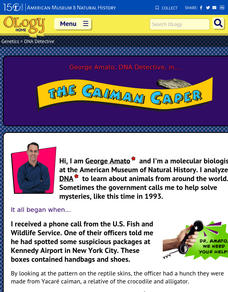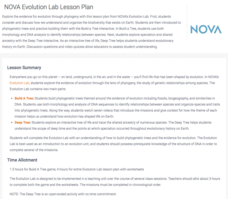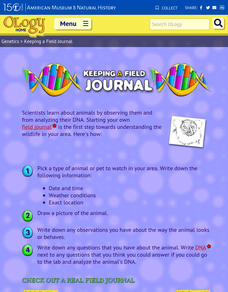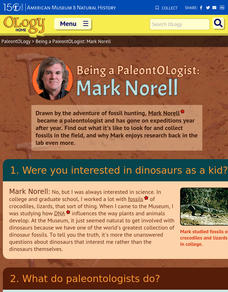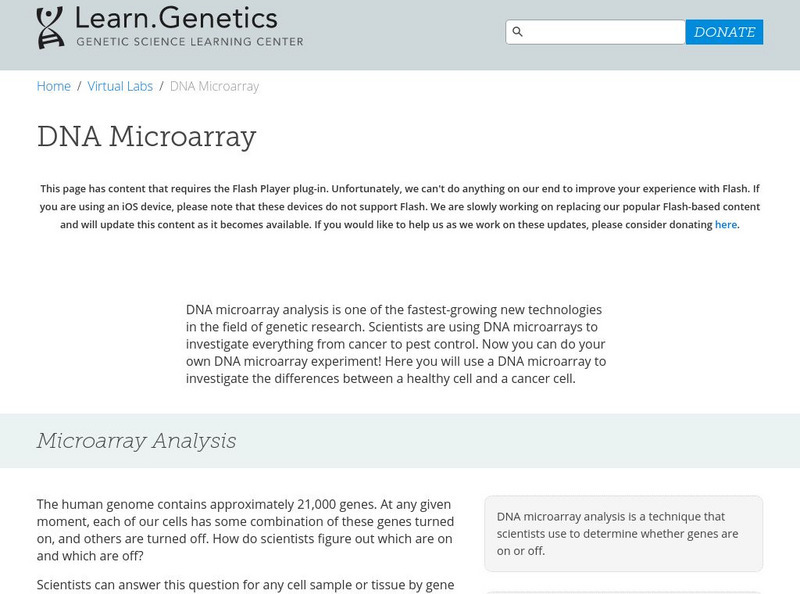American Museum of Natural History
DNA Detective
Match up the DNA code. Pupils read the website from the American Museum of Natural History about how DNA can determine whether a skin is from a particular type of reptile. Using the same technique, learners match up products with the...
PBS
NOVA Evolution Lab Lesson Plan
It doesn't matter if you look on land, in the air, underground, or in water—evolution is everywhere. Scholars complete worksheets with multiple question types as they progress through six online missions creating phylogenic trees.
Serendip
Genetics
A handout on genetic inheritance begins with a reading on alleles and how they can result in albinism. Junior geneticists learn to complete Punnett squares and participate in a coin toss simulation of allele pairing. They also learn...
Rice University
Biology for AP® Courses
An eight-unit electronic textbook provides a guide to AP® Biology. Each of the 28 chapters include an introduction, multiple lessons, a summary, review questions, and test prep questions. Teachers see how each lesson connects to a big...
American Museum of Natural History
Keeping a Field Journal
Young scientists begin a field journal by following four steps. A real-world example of an entry showcases the different parts, including location, date, drawings, and more.
American Museum of Natural History
Being a Paleontologist: Mark Norell
Get to know paleontologist Mark Norell with a 19 question interview. Written questions, answers, and photographs with descriptions sit among bright and cheery graphics
University of Utah
University of Utah: Dna Mircoarray Virtual Lab
This interactive lab will enhance learning about DNA by virtually translating a gene.
Smithsonian Institution
Lemelson Center: Spark!lab: Extract Dna
Dissect strawberries and use common household ingredients to successfully extract and examine the strawberry DNA.
National Health Museum
Access Excellence: Wolf Pack in a Bottle: Dna Simulation
This lesson plan can be used to illustrate the principle of electrophoresis without the equipment. Paper chromatography can be used to separate dye just like electrophoresis will separate DNA. The lab also covers DNA analysis for an...
Department of Defense
Do Dea: Biology: Unit 3: Cell Structure
In this third unit of a Biology course, students learn about cells and cell structure. They compare prokaryotic and eukaryotic cells and learn about the specialized structures in a cell and what their functions are. They will also learn...
TED Talks
Ted: Ted Ed: The Immortal Cells of Henrietta Lacks
Imagine something small enough to float on a particle of dust that holds the keys to understanding cancer, virology, and genetics. Luckily for us, such a thing exists in the form of trillions upon trillions of human, lab-grown cells...
Khan Academy
Khan Academy: The Rna Origin of Life Quiz
Try this quiz about RNA and the origin of life.
Khan Academy
Khan Academy: Protein Synthesis in the Cellular Factory Quiz
Try this quiz about RNA's role in protein synthesis.
Other popular searches
- Dna Replication Lab Activity
- Recombinant Dna Lab Report
- Label Dna Molecule
- Recombinant Dna Lab
- Dna Lab Activities
- Dna Mutation Lab Activity
- Dna Extraction Lab Protocol
- Strawberry Dna Lab
